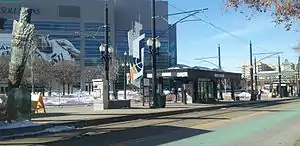Arena station (UTA)
Arena station is a light rail station in Downtown Salt Lake City, Utah, in the United States, served by the Blue Line and Green Line of the Utah Transit Authority's (UTA) TRAX system. The Blue Line has service from the Salt Lake Intermodal Hub in Downtown Salt Lake City to Draper. The Green Line has service from the Salt Lake City International Airport and to West Valley City via Downtown Salt Lake City.
 Arena station platform as seen from the north looking towards Delta Center | ||||||||||||||||||||||||||
| General information | ||||||||||||||||||||||||||
| Location | 301 West South Temple Salt Lake City, Utah United States | |||||||||||||||||||||||||
| Coordinates | 40°46′10″N 111°54′02″W | |||||||||||||||||||||||||
| Owned by | Utah Transit Authority (UTA) | |||||||||||||||||||||||||
| Platforms | 1 island platform | |||||||||||||||||||||||||
| Tracks | 2 | |||||||||||||||||||||||||
| Connections | ||||||||||||||||||||||||||
| Construction | ||||||||||||||||||||||||||
| Structure type | At-grade | |||||||||||||||||||||||||
| Accessible | Yes | |||||||||||||||||||||||||
| Other information | ||||||||||||||||||||||||||
| Fare zone | Free Fare Zone[3] | |||||||||||||||||||||||||
| History | ||||||||||||||||||||||||||
| Opened | December 4, 1999 | |||||||||||||||||||||||||
| Previous names | Delta Center (1999–2006) | |||||||||||||||||||||||||
| Services | ||||||||||||||||||||||||||
| ||||||||||||||||||||||||||
Description
The station is located at 301 West South Temple[4] immediately north of the Delta Center, with the island platform in the median of the street. The station opened on December 4, 1999, and was part of the first operating segment of the TRAX system.[5] It is operated by the Utah Transit Authority. The station is included in the Free Fare Zone in Downtown Salt Lake City. Transportation patrons that both enter and exit bus or TRAX service within the Zone can ride at no charge.[3] Unlike many TRAX stations, Arena does not have a Park and Ride lot.[4]
History
This station was originally the northern terminus of TRAX until April 27, 2008, when the extension to the Salt Lake Intermodal Hub (Salt Lake Central) opened[6] As of December 9, 2012 the Green Line was rerouted and Arena became the temporary northern terminus. With the opening of the airport extension on April 14, 2013, service continued on to the Salt Lake International Airport.
The station was closed during the 2002 Winter Olympics since it was in the Olympic Plaza. The countdown clock from the games still remains on the platform. It is in the shape of an arrowhead because of the Native American weapons that were unearthed during the construction of the station. Arena was previously called Delta Center, but when the name of the arena was changed to EnergySolutions Arena, the UTA Board of Trustees officially changed the station name to Arena in December 2006.[7] "EnergySolutions" was not included in the name as the UTA Board decided to no longer allow corporate names on stations.[8]
References
- "Salt Lake County System Map" (Map). Utah Transit Authority. April 14, 2022.
- "UTA On Demand". Utah Transit Authority. Retrieved July 22, 2022.
- Free Fare Zone (Map). Utah Transit Authority. Archived from the original on January 9, 2013. Retrieved February 27, 2013.
- "TRAX Parking and Stops". rideuta.com. Utah Transit Authority. Archived from the original on December 23, 2012. Retrieved March 2, 2013.
- Van Eyck, Zack (August 26, 1999). "All aboard! TRAX trains will roll in December". Deseret News. Salt Lake City: Deseret Digital Media. Retrieved February 28, 2013.
- Raymond, Arthur (April 18, 2008). "UTA to celebrate TRAX extension: Becker to talk today during event at new Planetarium Station". Deseret News. Salt Lake City: Deseret Digital Media. Retrieved April 1, 2013.
- "UTA trustees OK $238.9M budget". Deseret News. Salt Lake City: Deseret Digital Media. December 14, 2006. Retrieved February 28, 2013.
- Henetz, Patty (November 22, 2006). "TRAX changes signs on northbound trains". The Salt Lake Tribune. Salt Lake City: MediaNews Group. Retrieved March 18, 2014.
![]() Media related to Arena (UTA station) at Wikimedia Commons
Media related to Arena (UTA station) at Wikimedia Commons
